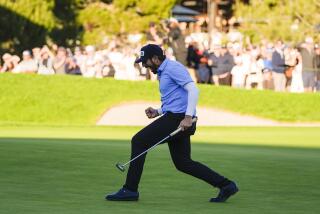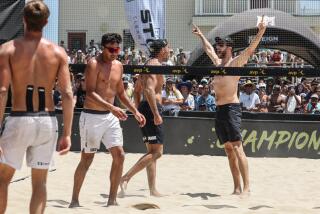It’s Time to Figure Out a New Way to Figure the Vardon Trophy Winner
- Share via
WASHINGTON — Don Pooley’s name is on the Vardon Trophy along with Sam Snead, Ben Hogan, Arnold Palmer, Lee Trevino, Tom Watson and most of the greatest golfers of the past 50 years.
And Pooley’s name should stay right there. He won the great honor fairly, if not quite squarely; he played by the rules. The man with the lowest stroke average on the PGA Tour in 1985 was, indeed, Don Pooley: 70.36.
However, the Vardon Trophy rules should be changed immediately so that no one ever again does what Pooley did.
What Pooley pulled was a fluke, like Joe Dokes finding a pack of cash dropped by a Brinks truck. Once is cause for bemused celebration.
Twice would be grand theft.
How big is the loophole in the Vardon system? Big enough to drive an entire Don Pooley through it.
Last year, Pooley finished 46th on the PGA Tour in money winnings. And that was his richest year ever. He didn’t finish first, second or third in any event--hardly a surprise, since Pooley has only one win in 11 pro seasons.
Yet, on the last day of the final tournament on the Vardon calendar, Pooley found himself just an eyelash away from copping a prize comparable to the batting championship in baseball.
Speaking of other Vardon contenders, such as Lanny Wadkins, Ray Floyd and Cal Peete, Pooley said, “To them, it would be just another feather in their cap. For me, it would be the only feather.”
Before the season’s final round, the computer told Pooley that to win, “I had to stay within six strokes of Wadkins. With four holes left (at Pensacola) that was down to two shots. . . . But I birdied two of the last four holes and won by .08 of a stroke. . . . It’s a story for the grandchildren. . . . probably the only thing that’ll be remembered about my career.
“There are some pretty heavy-duty names on that plaque. I can reel off quite a few of ‘em,” adds Pooley. “I’m very proud of the achievement.”
And he should be.
But how on earth did he do it?
As it turns out, easily.
Much too easily.
Pooley played most of the low-scoring courses on the Tour while skipping nearly every event played on a monster.
In ‘85, Pooley played 13 of the 16 PGA events in which the field scoring average was lowest (under 71.8). On the other hand, Pooley skipped 10 of the 15 toughest tracks. Most dramatic, of the seven courses where the field average was over 73.5, Pooley played only one.
By contrast, Curtis Strange (No. 1 money winner) played all 15 toughies.
Would this really be much of an advantage?
You bet your bogeys.
At the extremes in ’85 stood the Quad Cities Open (69.8) and the Crosby Pro-Am at murderous, blustery Pebble Beach (74.9). Just by scheduling one, rather than the other, a player would have gained 21 strokes in the Vardon.
“I didn’t realize that,” said Pooley when told he’d had the easiest schedule of the top 20 players in the Vardon race. “That would be an edge.”
Actually, it’d be the whole story.
“I never thought of myself as playing easier courses. I do avoid courses that are both tough and wide open off the tee because they don’t suit my game,” adds Pooley. “But last year I played the U.S. Open, the PGA, the TPC and Nicklaus’ Memorial. They’re all hard. And I skipped Quad Cities. I wouldn’t have done that if I were trying to (doctor) my schedule.”
No, he wouldn’t have. Pooley was playing it legit. He just lucked out.
Nonetheless, over a full season, the difference between the courses Pooley played and those Strange battled was almost 80 strokes.
So, how do we make a new system?
That’s easy, too.
First, let’s create a new term: Real Par. It’s simply the scoring average of the whole field for the week. Next, figure out the average Real Par of all the courses that a pro played in a season. Finally, subtract a player’s scoring average for the year from his Real Par average.
That tells us how much better he played than the field over the whole year--which is what the Vardon Trophy is all about.
Using this system for last year’s Vardon leader gives a whole new slant.
The winner is Corey Pavin. He played 12 of the toughest 15 courses for a Real Par rating of 72.52. His scoring average was 70.49. So, he was 2.03 strokes under Real Par for the year.
Is Pavin a suitable winner?
Absolutely. He had more top 10 finishes than any player (13) as well as the most top four finishes (seven). He was fourth under the old Vardon system.
On Pavin’s heels is Lanny Wadkins. Real Par: 72.39. Stroke average: 70.44. Rating: 1.95 strokes under Real Par.
Fittingly, Wadkins (the year’s No. 2 money winner) had 12 finishes in the top 10; only he and Pavin had more than nine top-10 finishes. Such consistent excellence is what the Vardon Trophy is supposed to symbolize.
Rounding out the elite of our Real Par scoring leaders are Ray Floyd (1.81), Craig Stadler (1.80) and John Mahaffey (1.77). Pooley was 1.59 strokes under Real Par; good, but back in the pack.
The Vardon Trophy is given by the PGA of America, a fairly conservative organization. The PGA Tour, however, tends toward innovation; commissioner Deane Beman says he’s “very interested” in devising a system that would factor course difficulty into scoring average.
“Something along these lines just makes sense,” he says. “Comparing performance to the scoring average of the whole field sounds logical.”
Pooley shouldn’t apologize for his new eminence. Just rub o’ the green.
But enough is enough. Two tainted Vardon winners in a row is too many.
Unless something like a Real Par system gets programmed into the Tour’s computer, the glamorous reputation of the old Vardon Trophy could degenerate into being just a Pooley Prize.
More to Read
Go beyond the scoreboard
Get the latest on L.A.'s teams in the daily Sports Report newsletter.
You may occasionally receive promotional content from the Los Angeles Times.










